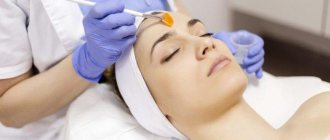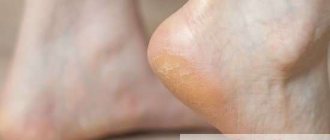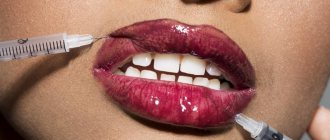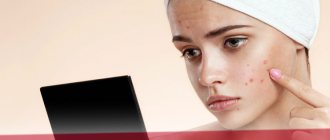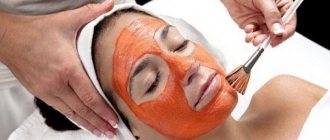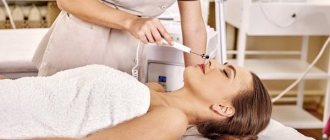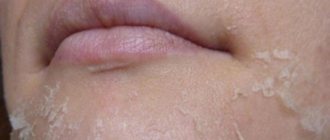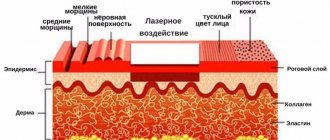What to do with rosacea
?
–
This question is more complex than it seems at first glance.
The problems underlying the causes of rosacea are problems not with the skin, but with blood vessels, so even after laser treatment for rosacea, spider veins may appear on the face again. Unconditional “once and for all” getting rid of rosacea, unfortunately, is not yet possible.
Fortunately, modern cosmetology has tools that help delay relapse or prevent it altogether.
But here, as the well-known literary hero said, saving drowning people is the work of the drowning people themselves. Some drugs and methods of modern cosmetology will be beneficial for rosacea, while others will only harm and provoke new spider veins.
What can be done with rosacea and what cannot be done with rosacea?
What kind of disease is this?
Couperosis is a manifestation of telangiectasia, or vascular “stars”, “mesh”, on the face, caused by impaired blood microcirculation due to increased fragility and expansion of capillaries. In addition to manifesting itself in the form of a cosmetic defect, rosacea indicates possible existing diseases of larger blood vessels.
Thin dilated capillaries cannot withstand external irritants: temperature changes, procedures using aggressive compounds and hard washcloths, towels.
The course of rosacea has three stages:
- Stage I is characterized by periodic “hot flashes”, during which a bright hyperemia of the skin appears, disappearing without a trace.
- Stage II – the appearance of a vascular pattern.
- Stage III is manifested by chronic microcirculation disorders with the appearance of inflammatory processes.
How to treat rosacea on the face?
There are several ways to treat rosacea and they all boil down to destroying and removing damaged capillaries.
Possible treatments:
- laser removal of blood vessels
- phototherapy
- electrocoagulation
- sclerotherapy
During sclerotherapy, a special drug is injected into the dilated vessels - a sclerosant, which blocks the capillaries, and over time they disappear without a trace. However, in the case of small vessels, this method does not work, therefore, it is mainly used to treat spider veins on the legs.
Electrocoagulation consists of introducing a subtle game into damaged capillaries, through which an electric discharge is released, destroying the vessel. The procedure is very long-term, moreover, it is painful and traumatic, as it is accompanied by a high risk of the formation of small scars. Therefore, today it is practically not used.
Will the procedure help?
There is a common misconception that peeling is contraindicated for sensitive skin with signs of rosacea. In fact, cosmetologists recommend this procedure.
Benefits of peeling for rosacea:
- the vascular network becomes less visible, the microrelief of the skin improves;
- turgor increases, facial and age wrinkles are reduced, the skin is smoothed;
- processes of cell renewal and regeneration are activated;
- acne, comedones and pimples disappear;
- pigment spots are smoothed out and become less noticeable.
For rosacea, only gentle types of peeling are suitable.
Answers on questions
Can scrubs be used for rosacea?
Scrubs can be used only in cases where long-term remission is observed. But you need to choose products with minimal abrasiveness.
How often should you peel for rosacea?
The procedure cannot be repeated often. It is acceptable to perform it once every 2 weeks for 1.5 months, after which there should be a break for 3 weeks.
What restrictions should be followed if there is rosacea?
To achieve stable remission, it is forbidden to visit the sauna, bathhouse, or solarium. It is important to monitor your diet: give up alcohol, spicy foods, coffee, chocolate.
Reviews from those who have already tried it
Anna, 27 years old:
I was pleased with the results after milk peeling. It is more gentle (compared with glycolic), there is no irritation or redness after the procedure. The skin became fresher.
Lyudmila, 33 years old:
Coral peeling helped me a lot. There was a vascular network that almost disappeared after 5 procedures.
Margarita (cosmetologist, work experience – 15 years):
Azelaine peeling is a great thing for rosacea. You can use products that act superficially: these are milk, almond, phytic, and also enzymatic. The interval between procedures must be at least 14 days. Be sure to strengthen the blood vessels after the procedure. It is also important to thoroughly moisturize your skin.
Can I use it and what type should I choose?
Any impact on skin affected by rosacea should be gentle and superficial. Too aggressive procedures increase vasodilation, increase the area of capillary stretching, and provoke inflammatory processes. Therefore, when choosing the type of peeling, they are guided by the depth of penetration of the active substance. It should not affect deeper than the granular layer of the dermis.
We recommend: What is coral facial peeling, how is it done and what is the care after the procedure?
Contraindications for all types of peeling:
- abrasions, especially bleeding ones;
- foci of inflammation;
- herpes;
- allergic reaction to the components of the procedure;
- pregnancy and lactation.
Chemical
Peeling, using a chemical composition, makes it possible to regulate the depth of action on the skin. This type of procedure is indicated for stages I and II of rosacea.
Important! The procedure is carried out after examining the condition of the blood vessels by a cosmetologist.
- Glycolic peeling penetrates the epidermis, gives a cleansing and rejuvenating effect, and activates regeneration. Apply to skin treated with alcohol-free lotion for 10 minutes and remove with a napkin.
- Peeling with azelaic acid has a calming and antiseptic effect, eliminates “stars”. Before the procedure, the skin is degreased, the composition is applied for 15 minutes and removed with wet wipes.
- Lactic acid, as part of the peeling, strengthens blood vessels and has an anti-inflammatory effect. Apply for 3-7 minutes and wash off with warm water. Recommended for use on hypersensitive skin prone to allergic reactions.
- Lactobionic acid narrows capillaries and removes pathogens. Apply to previously cleansed skin for 10 minutes. Wash off with warm water.
- Retinoic acid or yellow peel is used to constrict blood vessels and eliminate wrinkles on young skin.
- In adulthood, phytic cleansing is recommended. The exposure time of the composition is 10-15 minutes, after which it is washed off with water.
After the peeling procedure, a nourishing and moisturizing cream is applied to the face.
The skin after a chemical peel should not be heated or cooled. This should be taken into account at high temperatures in summer and during winter frosts.
Carbon
Carbon peeling gives excellent results at any time of the year and at any age. It has a gentle effect on the skin and is recommended at all stages of rosacea. However, at the first appointment, the cosmetologist will conduct a test for individual sensitivity to the substances included in the gel.
Carbon peeling combines the properties of chemical and physical peeling. Carbon dioxide gel is applied to the facial skin. It cleanses the deep layers of the dermis from impurities and toxins.
We recommend: What are exfoliants for the face and body, what types are there and how to use them?
The gel layer is exposed to a laser beam to accelerate regeneration and metabolic processes. It regulates the depth and area of exposure to carboxylic acid. The total procedure time is 20-30 minutes.
When a laser beam interacts with carbon particles, capillaries narrow, dead cells and sebaceous plugs, which lead to inflammation, are destroyed. After the session, the skin acquires a “porcelain” effect. Becomes smooth, even and radiant. This effect lasts for a long time.
Important! Carbon peeling is subject to general contraindications for all types. It is also not recommended for diabetes and cancer.
What peelings are indicated?
The peeling procedure, aimed against stagnation of blood in the capillaries, should be carried out with low concentration reagents. In case of rosacea, chemical peeling at the initial stage should not penetrate deeper than the basal layer of the epidermis. Certain types of hardware and physical exfoliations (at most mid-superficial techniques) can be performed with caution.
After this procedure, which is a kind of stress for the skin, it has an incentive to renew itself, the oval of the face is tightened, and the turgor improves. Freckles, blackheads and age spots disappear on the face.
What is prohibited?
The type of peeling to eliminate rosacea and other manifestations of the disease is selected individually. At any stage of rosacea it is strictly prohibited:
- The use of salicylic acid due to the possibility of spreading irritation and enlarging the stars and capillary network.
- Jesner peeling. The drug contains salicylic acid and resorcinol. After this type of procedure, there is a possibility of the capillary network spreading to other areas of the facial skin due to the deep impact on the dermis. Prohibited even with single signs of rosacea.
- TCA leads to the spread of rosacea due to the content of highly concentrated trichloroacetic acid. During cleansing, the drug destroys skin cells to activate renewal, and with them blood vessels.
- Despite the gentle and shallow effects on the skin, phytopilling is not recommended. To achieve the result, 5 procedures are carried out with a mixture containing natural salicylates, phytoestrogens and other active substances. With rosacea, the skin is thinned and has increased sensitivity, so such a number of fairly aggressive procedures will lead to side effects, including an increase in the area with rosacea mesh.
Types of yellow (retinoic) peeling
Cosmetologists offer patients two types of procedures:
- classical - retinoic;
- gentle - retinol.
In the first case, synthetic retinoic acid is used, in the second, natural retinol. Gentle peeling has a gentle effect on the skin, but you have to wait a while for results. Facial cleansing using this method can be done frequently; no prior skin preparation is required.
The use of classic peeling is limited to two to three courses per year. Each of them consists of three procedures. The break between them is 2 weeks.
Based on the duration of the procedure, retinoic cleansing is divided into:
- one-day;
- two days.
In the first case, the entire complex of manipulations is carried out in 1 day. The patient removes the mask from the face independently 12 hours after the end of the procedure. With a two-day peeling, the face is treated for 2 days. On the first day, the mixture is applied several times. Before each subsequent treatment, the skin is cleansed of the previous mask. The patient removes the latter at home 2 hours after its application. On the second day the procedure is repeated.
Technique and features of the procedure
In case of rosacea, the course and procedure for peeling differ from the usual ones.
For the procedure to have a beneficial effect, you should adhere to a number of recommendations:
- Before starting the first procedure, a doctor is consulted. This is done even in the remission stage.
- The course is shortened.
- Breaks between procedures are at least two weeks.
- The peeling composition is applied first to healthy areas of the skin, and then to damaged ones. It is neutralized in the reverse order, first of all removed from problem areas.
- The course is carried out under constant monitoring of the skin condition. If there are signs of exacerbation or spread of rosacea, the procedures are cancelled.
- After peeling, medications are prescribed to strengthen the walls of blood vessels.
- The skin should be provided with increased care, choosing creams and masks with hyaluronic acid, plant collagen, jojoba, grape seed, and sweet almond oils.
We recommend: All about peeling with fruit acids. Who is it indicated for, are there any restrictions, how is it carried out, can it be done at home?
There is no peeling after yellow peeling: what to do?
The main external sign of the quality of yellow peeling is the exfoliation of dead epidermal cells. Therefore, its absence alarms the patient, causing him to doubt the professionalism of the cosmetologist. However, the skin may not peel off for various reasons:
- Too little time has passed. With superficial cleaning, peeling of small scales will be observed after a couple of days. Medium to deep cleansing causes large dry patches to appear within 5-14 days. The drug supplier or esthetician will tell you exactly what day after the procedure you can expect peeling.
- In some people, the epidermis is naturally highly resistant to damage. In this case, the skin will not peel off even after retinoic peeling. And in some cases, even ordinary skin is covered with such a thick layer of dead cells that the usual preparation for the procedure is not able to loosen it.
- The patient decided to undergo chemical peeling for the first time in his life, and the specialist deliberately prescribed him a gentle procedure. In this case, peeling will be barely noticeable.
- Perhaps the stratum corneum is so thin that it is peeled off the moment the yellow mask is removed.
Despite the absence of peeling, you should take care of your skin after peeling as usual.
Video about skin care after peeling using a moisturizing facial serum
Expert advice
- To maintain the effect for a long time, experts recommend avoiding aggressive effects on the epidermis and refusing to use:
- soap;
chlorinated water;
- alcohol lotions;
- creams with fruit acids and irritating natural substances such as honey and essential oils.
- Additional skin support will be provided by care products with vitamins, licorice extract, green tea and soothing ingredients.
- When carrying out the peeling procedure at home, it is recommended to follow the order of applying and removing peeling: apply first to healthy areas, and remove first from the affected ones.
They should be replaced with soft cleansing foam, cosmetic milk, distilled water, and mousses.
Massage and ultrasound procedures using current during the course of peeling for rosacea are performed upon the appointment of a specialist and after consultation with a dermatologist.
Couperosis can be eliminated, especially in the initial stages. Specialists will cope with the manifestation of the problem and the face will become beautiful and elastic again. This effect is achieved only if all recommendations are followed.
Violating the prescriptions of specialists, using drugs and mixtures prohibited for rosacea leads to consequences that will require more serious procedures to eliminate.
Mandelac
This type of cleansing is intended for people who cannot tolerate glycolic acid and are also prone to age spots. The product helps get rid of acne, smooth out wrinkles and whiten the skin surface. Due to the fact that blood circulation increases after the composition, it helps fight rosacea.
Effect of carbon peeling
The result is noticeable immediately, but the maximum effect is achieved after completing the full course.
- The complexion becomes pleasant and attractive, acquires a healthy shade.
- The pores become narrower.
- Turgor is improving.
- Inflammatory processes are eliminated.
- The skin around the eyes becomes firmer and more elastic.
As our patients note, after a carbon peeling session, the skin of the face seems to wake up after a long hibernation; you even want to touch it to feel the pleasant changes.
